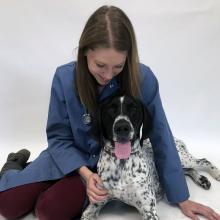Hey everyone! Week three was another busy week at Picton Animal Hospital! This week I got lots of practice with diagnostics, and did my first solo spay surgery!
A quick recap from the quiz in my previous blog (Itching, Scratching and Scooting)
.JPG)
.JPG)
In third year of OVC, we get practice doing spay and neuter surgeries in dogs and cats in groups of three, with a collection of experienced surgeons and anesthesiologists alongside us to make sure that nothing goes wrong in those critical first surgeries of our careers. In practice however, we will be expected to perform surgery with minimal, if any, assistance. It is important for us to use externship and our fourth-year rotations to develop our confidence so that by this time next year, we can be reasonably comfortable performing solo surgeries (at least for a handful of routine procedures).
Monday was a holiday, so the clinic wasn’t open, but on Tuesday I got to scrub into my first surgery at PAH as an assistant, and got to practice suturing (placing stitches) and locating the uterus within the abdomen for a spay. On Wednesday, I performed a cat neuter with supervision. On Friday, I rounded off my week by performing two neuters and a spay on barn cats from a local farm! I’m very fortunate for the trust and confidence that the clinic has in me, and that the veterinarians are always on the lookout for opportunities for me to take the lead in a patient’s care.
This week I also got to assist with the diagnosis of one of our classic big dog diseases: cruciate ligament rupture. The anterior/cranial cruciate ligament (ACL in humans, CCL in dogs) is located in the stifle (knee), and is a common site of injury in both people and dogs. The main difference is that in people, it is usually a traumatic injury obtained from a sudden twisting motion in a sport such as soccer or skiing, whereas in dogs, it is a degenerative disease in which the ligament wears down over time, and a simple, everyday motion such as jumping off the couch or fetching a ball can be the final straw and cause the ultimate rupture. Some of the factors involved in cruciate ligament disease in dogs include breed, genetics, obesity, and lifestyle (couch potatoes are less likely to run into this problem).
We diagnose cruciate ligament ruptures primarily by performing a “drawer test” on the leg in question. Some dogs may tolerate this procedure while awake; however, since they are often sore and painful, we typically get a better-quality diagnosis and it is nicer for the animal if we use heavy sedation or anesthesia. The drawer test involves stabilizing the femur with one hand and the seeing if the tibia can be moved forward with the other hand (it shouldn’t be able to in a normal stifle). The veterinarian will perform the test on both legs to identify if there is a difference in the amount of laxity (movement) in each joint.
This video describes the drawer test for cranial cruciate ligament rupture (I take no credit for this video!)
This week we had two patients come in for CCL rupture diagnosis. It was my first time performing the drawer test on abnormal patients, so it was a great opportunity for me, however not so great for my patients! There are several treatment options for this disease, including strict cage rest for several weeks and then slow, controlled return to activity, however like in humans, surgery offers the best chance of the dog returning to its previous level of capability.
I got to practice my microscope skills (which aren’t very good!) a lot in week three by looking a several ear swabs, skin swabs, and skin scrapings. Can anyone tell me what these organisms are? The picture on the left is from an ear swab and the picture on the right is from a skin scraping.
That’s it for today! As always, thanks for reading, and have a great week!

.JPG)
.JPG)